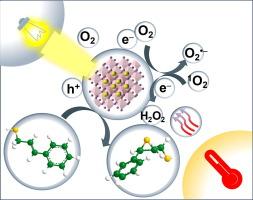Localized surface plasmon resonance effect–mediated in-situ photochemical–formation of H2O2 for high epoxidation performance over LaSrCoNiO6 nanoparticles
IF 6.5
1区 化学
Q2 CHEMISTRY, PHYSICAL
引用次数: 0
Abstract
Selective aerobic epoxidation of allylic alcohols and olefins presents a promising solution to the modern chemical industry. However, the development of non-noble metal catalysts with superior catalytic performance for this reaction remains a significant challenge. This study introduces a plasmonic photothermal-catalytic system centered around nano LaSrCoNiO6 (LSCNi-N) catalyst, enabling the epoxidation of cinnamyl alcohol and styrene mediated by LSPR effect under visible light illumination (>420 nm). This catalyst exhibits superior epoxidation catalytic performance, with selectivities of up to 72.3 % in a 93.4 % conversion of cinnamyl alcohol and 91.8 % selectivity of styrene oxide at almost 100 % conversion of styrene. Mechanistic studies reveal that the high selectivity derives from the in-situ photochemical formation of H2O2 mediated by the localized surface plasmon resonance effect of LSCNi-N and hole scavenger effect of cinnamyl alcohol. These findings highlight the potential of designing plasmonic transition-metal oxidic catalysts to overcome challenges in selectively synthesizing fine chemicals through visible light catalysis.


局部表面等离子体共振效应介导的 H2O2 在 LaSrCoNiO6 纳米粒子上原位光化学转化,实现高环氧氧化性能
烯丙醇和烯烃的选择性有氧环氧化反应为现代化学工业提供了一种前景广阔的解决方案。然而,为该反应开发催化性能优越的非贵金属催化剂仍是一项重大挑战。本研究介绍了一种以纳米 LaSrCoNiO6(LSCNi-N)催化剂为核心的等离子体光热催化系统,在可见光(420 纳米)照射下,通过 LSPR 效应介导肉桂醇和苯乙烯的环氧化反应。这种催化剂具有卓越的环氧化催化性能,在肉桂醇 93.4% 的转化率下,其选择性高达 72.3%;在苯乙烯几乎 100% 的转化率下,其对氧化苯乙烯的选择性高达 91.8%。机理研究表明,高选择性源于 LSCNi-N 的局部表面等离子共振效应和肉桂醇的空穴清除效应介导的 H2O2 的原位光化学形成。这些发现凸显了设计质子过渡金属氧化催化剂的潜力,以克服通过可见光催化选择性合成精细化学品的挑战。
本文章由计算机程序翻译,如有差异,请以英文原文为准。
求助全文
约1分钟内获得全文
求助全文
来源期刊

Journal of Catalysis
工程技术-工程:化工
CiteScore
12.30
自引率
5.50%
发文量
447
审稿时长
31 days
期刊介绍:
The Journal of Catalysis publishes scholarly articles on both heterogeneous and homogeneous catalysis, covering a wide range of chemical transformations. These include various types of catalysis, such as those mediated by photons, plasmons, and electrons. The focus of the studies is to understand the relationship between catalytic function and the underlying chemical properties of surfaces and metal complexes.
The articles in the journal offer innovative concepts and explore the synthesis and kinetics of inorganic solids and homogeneous complexes. Furthermore, they discuss spectroscopic techniques for characterizing catalysts, investigate the interaction of probes and reacting species with catalysts, and employ theoretical methods.
The research presented in the journal should have direct relevance to the field of catalytic processes, addressing either fundamental aspects or applications of catalysis.
文献相关原料
公司名称
产品信息
阿拉丁
Urea
阿拉丁
Citric acid
阿拉丁
Ni(NO3)2·6H2O
阿拉丁
Co(NO3)2·6H2O
阿拉丁
Sr(NO3)2
阿拉丁
La(NO3)2·6H2O
 求助内容:
求助内容: 应助结果提醒方式:
应助结果提醒方式:


